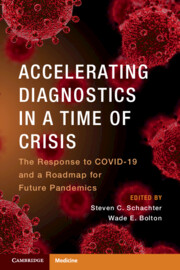Refine search
Actions for selected content:
88 results
Visual diagnostics for female genital schistosomiasis and the opportunity for improvement using computer vision
-
- Journal:
- Parasitology , First View
- Published online by Cambridge University Press:
- 12 September 2025, pp. 1-12
-
- Article
-
- You have access
- Open access
- HTML
- Export citation
5 - Clinical Manifestation, Complexity of Catatonic Symptoms, Differential Diagnoses, and Potential Somatic Consequences
-
- Book:
- Catatonia
- Published online:
- 26 July 2025
- Print publication:
- 14 August 2025, pp 59-78
-
- Chapter
- Export citation
Recognition of Toxocara canis excretion-secretion antigens in the serum of children with epilepsy. Involvement in the diagnosis of visceral larva migrans
-
- Journal:
- Journal of Helminthology / Volume 99 / 2025
- Published online by Cambridge University Press:
- 08 August 2025, e92
-
- Article
- Export citation
What to Observe When Assuming Selection on Observables
-
- Journal:
- Political Analysis , First View
- Published online by Cambridge University Press:
- 27 June 2025, pp. 1-22
-
- Article
-
- You have access
- Open access
- HTML
- Export citation
Closing the diagnostic gap in male genital schistosomiasis (MGS): current detection tools and novel strategies
-
- Journal:
- Parasitology , First View
- Published online by Cambridge University Press:
- 24 June 2025, pp. 1-10
-
- Article
-
- You have access
- Open access
- HTML
- Export citation
Clinical Implementation and Outcomes of Genetic Testing for Epilepsy by the Ontario Epilepsy Genetic Testing Program
-
- Journal:
- Canadian Journal of Neurological Sciences , First View
- Published online by Cambridge University Press:
- 14 April 2025, pp. 1-12
-
- Article
-
- You have access
- Open access
- HTML
- Export citation
Evaluation of the recombinant protein Sh-TSP-2 for the serological diagnosis of imported urogenital schistosomiasis and comparison with commercially available tests
-
- Journal:
- Parasitology / Volume 152 / Issue 1 / January 2025
- Published online by Cambridge University Press:
- 22 January 2025, pp. 72-81
-
- Article
-
- You have access
- Open access
- HTML
- Export citation
Reasoning about physical processes in buildings through component stereotypes
- Part of
-
- Journal:
- Data-Centric Engineering / Volume 5 / 2024
- Published online by Cambridge University Press:
- 16 December 2024, e40
-
- Article
-
- You have access
- Open access
- HTML
- Export citation
A scintillating fiber imaging spectrometer for active characterization of laser-driven proton beams
-
- Journal:
- High Power Laser Science and Engineering / Volume 12 / 2024
- Published online by Cambridge University Press:
- 03 December 2024, e70
-
- Article
-
- You have access
- Open access
- HTML
- Export citation
1 - Interaction Research and Dementia
- from Part 1 - Introduction
-
-
- Book:
- Dementia and Language
- Published online:
- 21 November 2024
- Print publication:
- 28 November 2024, pp 3-22
-
- Chapter
-
- You have access
- HTML
- Export citation
3 - Multiple Linear Regression
-
- Book:
- A Practical Guide to Data Analysis Using R
- Published online:
- 11 May 2024
- Print publication:
- 30 May 2024, pp 144-207
-
- Chapter
- Export citation
Development of an ultrathin liquid sheet target for laser ion acceleration at high repetition rates in the kilohertz range
-
- Journal:
- High Power Laser Science and Engineering / Volume 12 / 2024
- Published online by Cambridge University Press:
- 01 April 2024, e37
-
- Article
-
- You have access
- Open access
- HTML
- Export citation
Introduction
-
-
- Book:
- Accelerating Diagnostics in a Time of Crisis
- Published online:
- 06 January 2024
- Print publication:
- 07 March 2024, pp 1-5
-
- Chapter
-
- You have access
- HTML
- Export citation
A comprehensive diagnostic system of ultra-thin liquid sheet targets
-
- Journal:
- High Power Laser Science and Engineering / Volume 12 / 2024
- Published online by Cambridge University Press:
- 05 March 2024, e26
-
- Article
-
- You have access
- Open access
- HTML
- Export citation
Analysis of insecticide resistance and de novo transcriptome assembly of resistance associated genes in the European grapevine moth, Lobesia botrana (Lepidoptera: Tortricidae)
-
- Journal:
- Bulletin of Entomological Research / Volume 114 / Issue 1 / February 2024
- Published online by Cambridge University Press:
- 08 February 2024, pp. 88-98
-
- Article
- Export citation

Accelerating Diagnostics in a Time of Crisis
- The Response to COVID-19 and a Roadmap for Future Pandemics
-
- Published online:
- 06 January 2024
- Print publication:
- 07 March 2024
Vectorized Clay Nanoparticles in Therapy and Diagnosis
-
- Journal:
- Clays and Clay Minerals / Volume 67 / Issue 1 / 15 February 2019
- Published online by Cambridge University Press:
- 01 January 2024, pp. 25-43
-
- Article
- Export citation
Chapter 7 - Assessing the Impacts of Problematic Benford Validity
-
- Book:
- Applying Benford's Law for Assessing the Validity of Social Science Data
- Published online:
- 09 November 2023
- Print publication:
- 23 November 2023, pp 169-187
-
- Chapter
- Export citation
5 - New product development (NPD)
-
- Book:
- Commercializing Successful Biomedical Technologies
- Published online:
- 03 November 2022
- Print publication:
- 17 November 2022, pp 163-238
-
- Chapter
- Export citation
4 - Intellectual property and licensing
-
- Book:
- Commercializing Successful Biomedical Technologies
- Published online:
- 03 November 2022
- Print publication:
- 17 November 2022, pp 122-162
-
- Chapter
- Export citation
